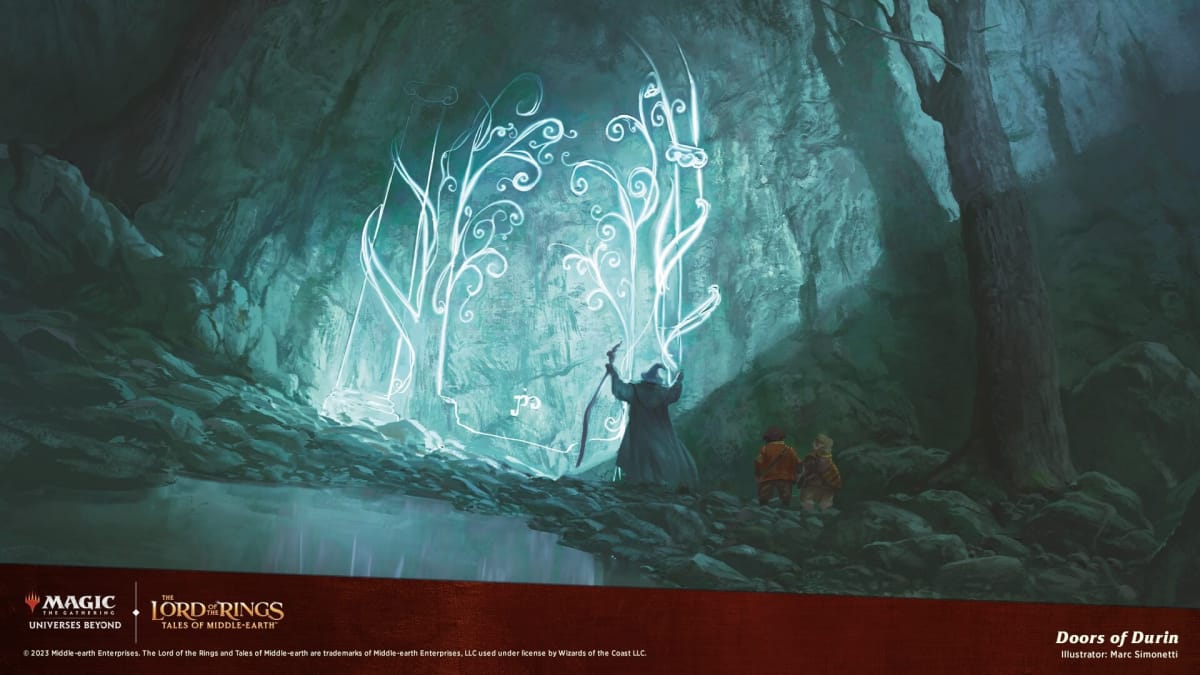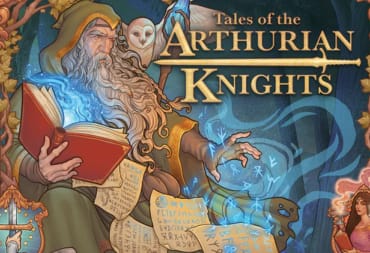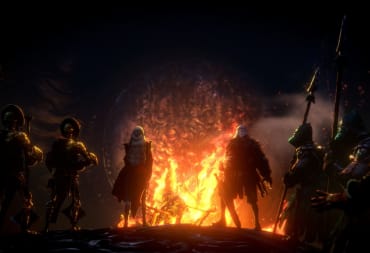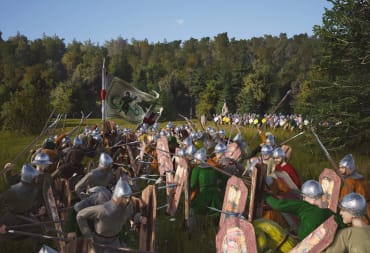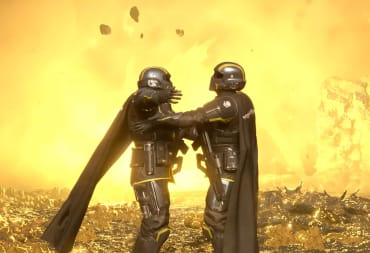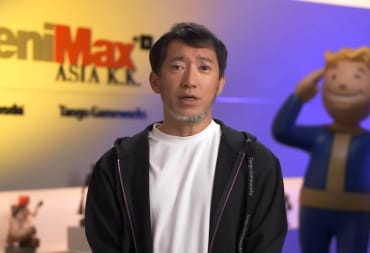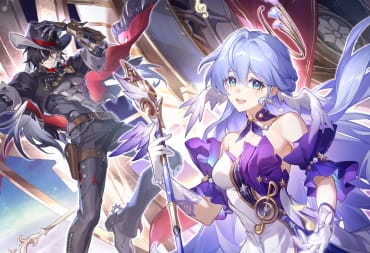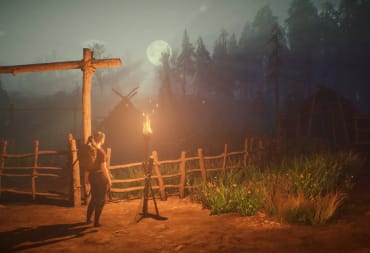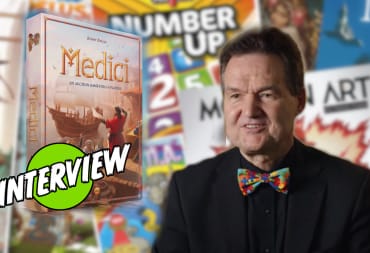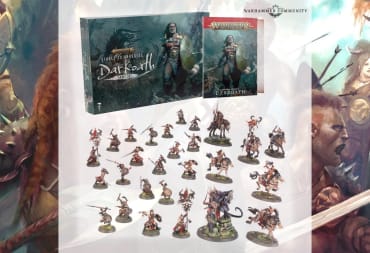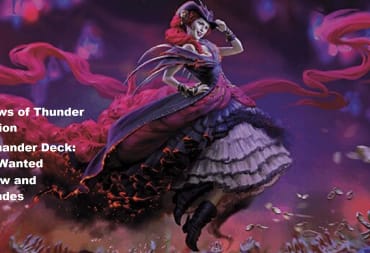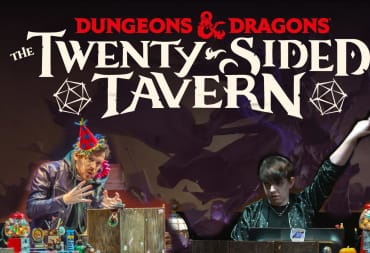Many people were introduced to Lord of the Rings by Peter Jackson’s great adaptation of the books into the trilogy of films. However, no matter how accurate or comprehensive an adaptation is, there are going to be things changed or left out. With Lord of the Rings: Tales of Middle-earth adapting the books you may be left wondering about what is going on with some of the cards if you only know the films.
So today we’re digging beyond the films into Tales of Middle-Earth and talking about those cards that adapt parts of the books that didn’t make the films. I’ll try to provide context, some introduction to the story elements, and look at the cards in question with you.
Gildor, and Elves Around the Shire in Magic: The Gathering
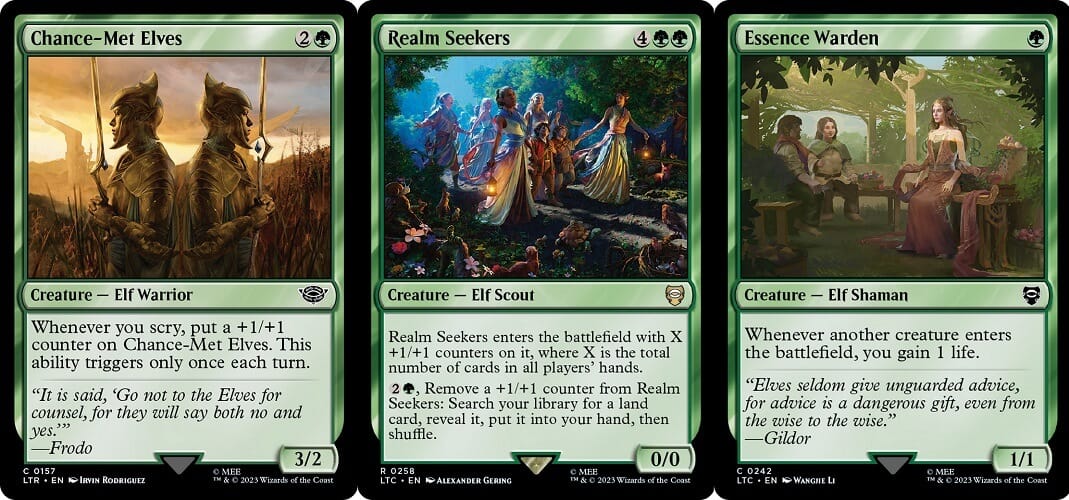
Even before we make it to Rivendell, Frodo demonstrates to us that he is an elf-friend and has learned more about the outside world than most hobbits. In the third chapter of Fellowship of the Ring, we see Frodo, Pippin, and Sam, meet with some Nordor elves led by Gildor Inglorion as they are on their way to Buckland. Shown in the card Chance-Met Elves, we have a card that uses scrying to represent the search for information, which fits Frodo seeking advice from Gildor.
There are several other references to this meeting, though oddly no legendary creature card for Gildor. The card Realm Seekers appears to reference the fact that the Nordor elves here are wandering and exploring before going to take a boat to the Grey Havens and hosts the hobbits for a night. Additionally, the flavor text of Essence Warden shows another part of the conversation Gildor and Frodo have that we previously referenced in Chance-Met Elves. While this is a minor part of the story, overall, Gildor is the one who passes word ahead to others like Aragorn and Tom Bombadil that Gandelf didn’t make it to the Shire and that the hobbits are on their way, making it quietly important to the story.
Tom Bombadil and the Old Forest in Magic: The Gathering
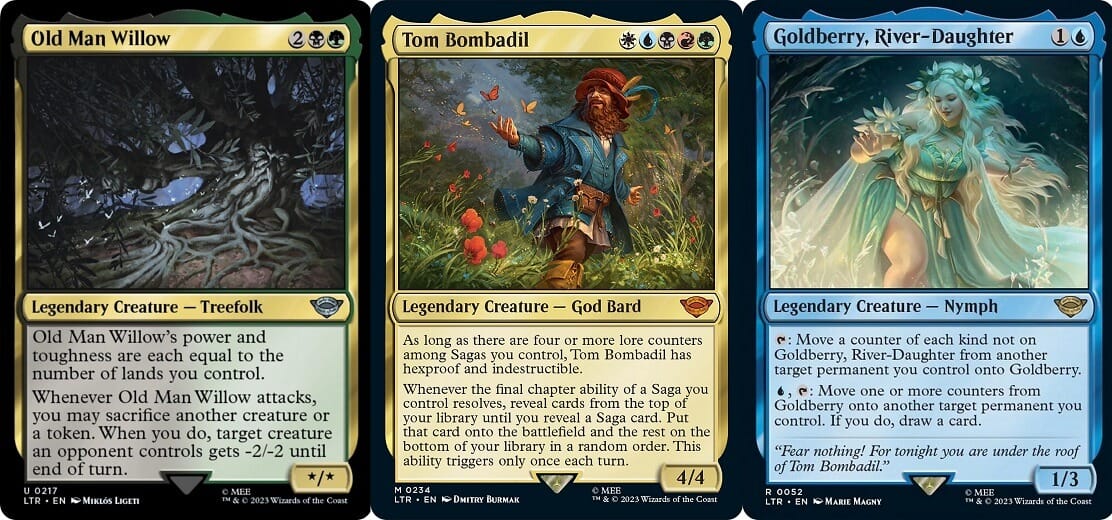
One segment notably cut in the Lord of the Rings films is the journey through the Old Forest east of Buckland and then the trip through the barrow-downs. Closer in tone to The Hobbit, this area helps set a transitional tone from whimsy such as seen in the Shire to the darkness that is besetting Middle-Earth. It shows both how at this early stage the hobbits are out of their depth and some of the unexplained magic of the world.
As they get lost in the Old Forest, Old Man Willow uses his magic to lull the hobbits to sleep. This evil tree (a contrast to the later Ents) then pulls Merry and Pippin into his trunk, before Tom Bombadil arrives to rescue the hobbits. Old Man Willow’s card demonstrates why he’s weak to Tom Bombadil because his power depends on the land, and in this part of Middle-Earth the land answers to Tom first. It also shows him eating things (sacrificing a creature or token) to consume more (shown by giving another creature -2/-2).
Tom Bombadil is an enigma in the world of Middle-Earth – the oldest being and one not affected by the Ring in any way. He’s not a fit guardian for it because its lack of impact is so total he doesn’t really get what a big deal it is and would soon lose track of it. In the book, he is always telling tales and singing songs, and his card represents this with a hefty focus on Sagas. The idea of him being almost impossible to destroy while in his area isn’t perfectly captured, but is represented with his indestructibility as long as you have enough lore counters on sagas.
His wife Goldberry also gets a card with Goldberry, River-Daughter. Another enigma, not much is known about her, though it is alluded to that she might be a spirit of the river or something similar. This lack of knowledge is perhaps why her card doesn’t have as much resonance as Tom Bombadil or others, but it fits with the idea of changing seasons, and water levels, by moving counters to and fro as time goes by.
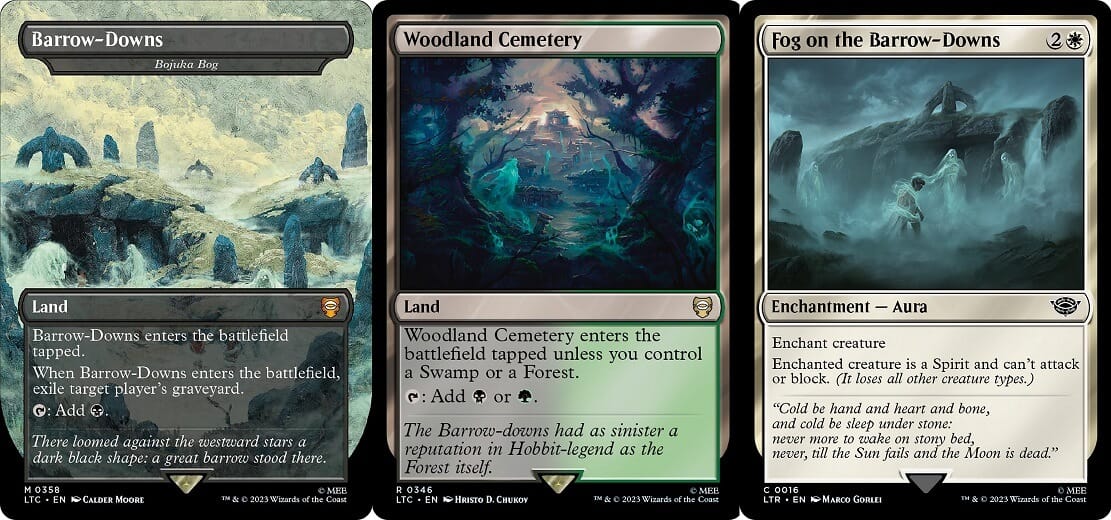
When the hobbits leave the Bombadil household and continue on their journey, they run into trouble at the edge of Tom Bombadil’s range. The Barrow-Downs are depicted in one of the Box-Toppers as an alternate of Bojuka Bog, and is where many Dunedain were laid to rest in the past. The Witch King of Angmar sent evil spirits there to prevent resettlement and they have haunted the area for a long time since. The region is further depicted in the Lord of the Rings Commander version of Woodland Cemetery, and the card Fog on the Barrow-Downs which shows how dangerous the place can be for a creature turning it into a spirit that can’t do anything.
Tom Bombadil saves the hobbits, and it is with Bombadil’s Song that the wights are stopped from killing our heroic hobbits. The +1/+1 and hexproof of the instant make a lot of sense as it helps explain why they couldn’t target them, with Bombadil effectively casting this spell for each of the hobbits. The odd part of the card is it then has The Ring Tempts You, as Bombadil is immune to the ring. While it makes the card play better, it doesn’t do a great job of fitting the flavor of Tom Bombadil.
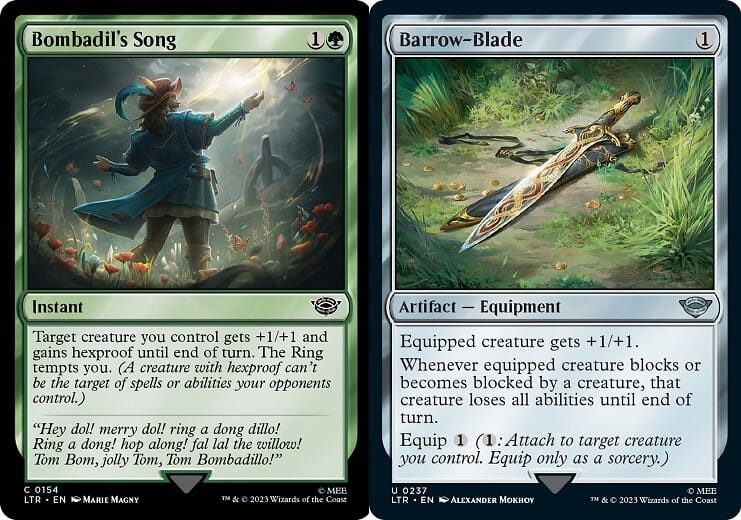
From the barrows, Tom Bombadil gifts the hobbits with the barrow blades from the tombs the wights haunted. The Barrow-Blades have nothing to do with Aragorn here and they become key weapons for the hobbits. Frodo would eventually break his on the way to Rivendell and replace it with Sting but the other hobbits would continue to use them for a long time, it is key to Merry beating the Witch King of Angmar due to the enchantment the ancient Dundain had put on the blade to be anathema to their old foe. The Barrow-Blade card captures that by removing all abilities when the creature is engaging in combat, meaning it removes the indestructibility the Witch-King of Angmar can gain, letting him die.
The Scouring of the Shire in Magic: The Gathering
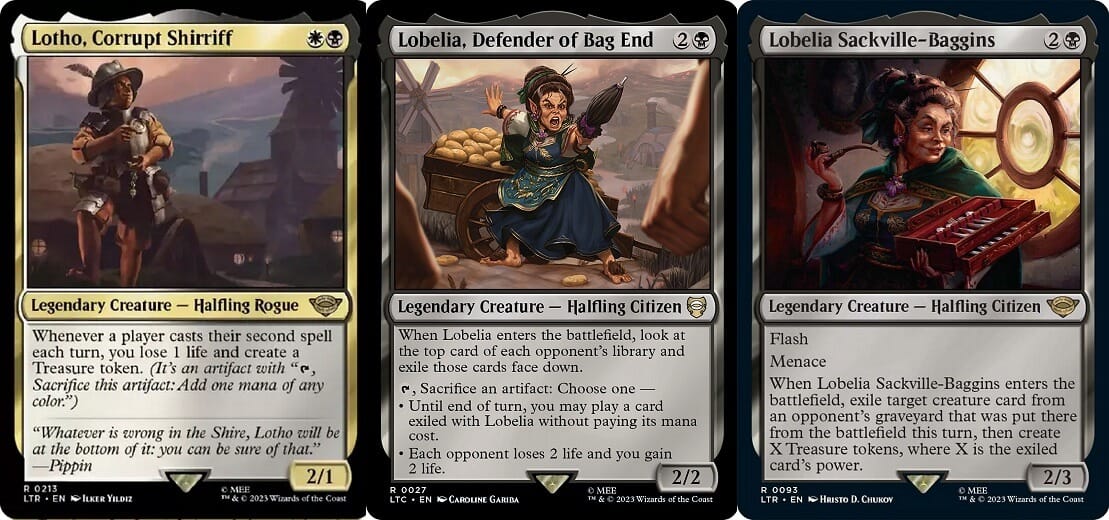
There is an entire return to the Shire in the books that wasn't made for the Return of the King movie. Called the Scouring of the Shire, it involves returning home to find not only have they changed... but the world had not ignored home either. All was not peaceful there, as first, we had the Sackville-Baggins take over large swathes of the Shire and begin industrializing it, to sell pipeweed to Saruman for example. Here we see Lotho, Shire Shirriff, and his treasure-making ways shown as he makes money (treasure) when others are doing things (casting spells).
Lobelia, his wife has two cards in Lobelia, Defender of Bag End, and Lobelia Sackville-Baggins. The first captures her protecting what she's taken from others in the art, and her abilities also capture her looting all that stuff. The second, has her being a gold digger, and depicts her getting Bilbo’s spoon collection. Both capture the mean-spirited heart of this character, but this is only the beginning of the problems in the Shire.
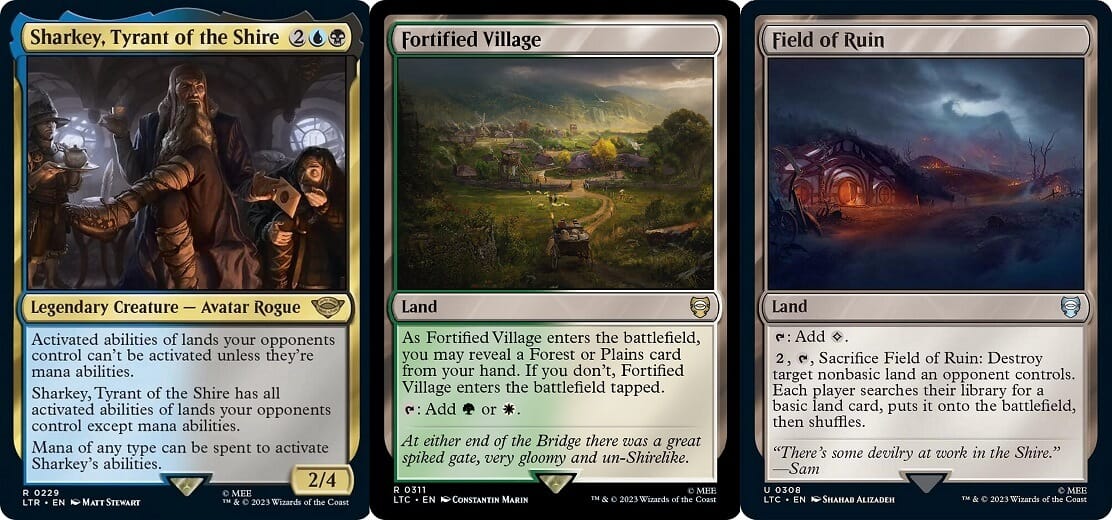
In the art and flavor texts for Fortified Village and Field of Ruin, we see the changes that have happened since our adventurous hobbits set forth. Great spiked gates are closed in Buckland, and the sweet rural countryside is changed. We find out more about who is behind the scenes – Sharkey, Tyrant of the Shire. While you may not recognize that name, you do know the character. See, in the books, Saruman doesn’t die at Isengard, instead, Gandelf breaks his staff, banishes him from the White Council, and takes most of his power away leaving him under the guard of the Ents.
Using his wiles, Saruman convinced them to let him go, and seeking revenge on the hobbits that so ruined his plans, he goes to the Shire with some flunkies (ruffians he’d hired, and others including Grima), and is called Sharkey by them. His card reflects his status – gone is the powerful magics, but instead a tyrant over the lands now under his control. He has confiscated all that is special about the land around him for himself.
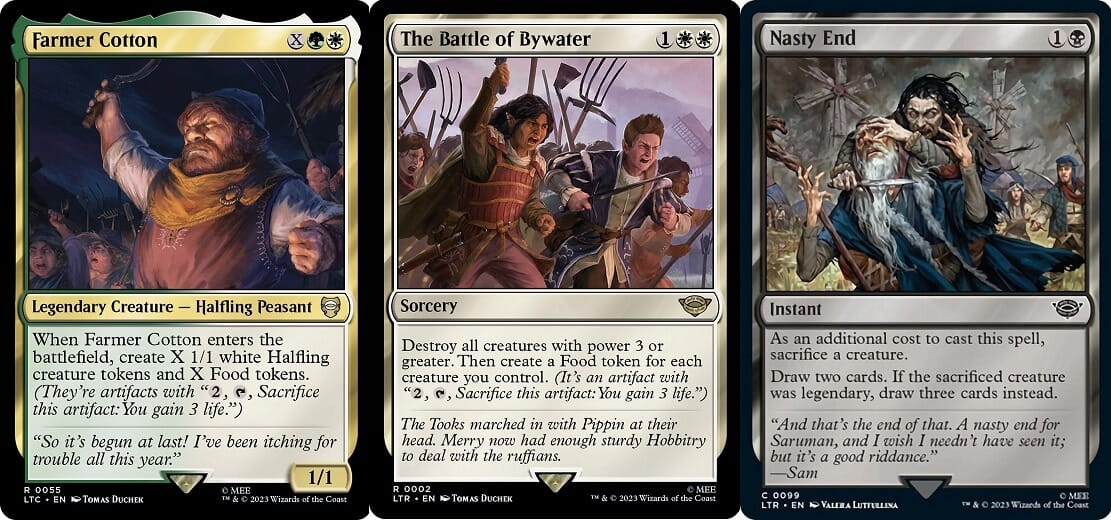
Our heroes lead a rebellion against Sharkey, his flunkies, and his collaborators. Partnering with Farmer Cotton and others, Merry and Pippin led the Battle of Bywater, where the hobbits took the fight to the roughly 150 ruffians – a mixture of wildmen, half-orcs, and foreign hobbits. The Shirefolk win the battle, and confront Sharkey in his lair, where he tries to kill Frodo one last time, which was thwarted by Frodo’s Mithril Coat. He would meet a Nasty End when Grima finally has been pushed too far, and takes his knife to Saruman’s throat. Arrows would shortly thereafter hit Grima from hobbit archers who were backing up the heroes, bringing an end to a sordid affair.
The restoration of the Shire would follow, as we can see in Revive the Shire, and Seeds of Renewal. It would become Sam’s life rebuilding the Shire, and his daughter would also inherit his ties to the land.
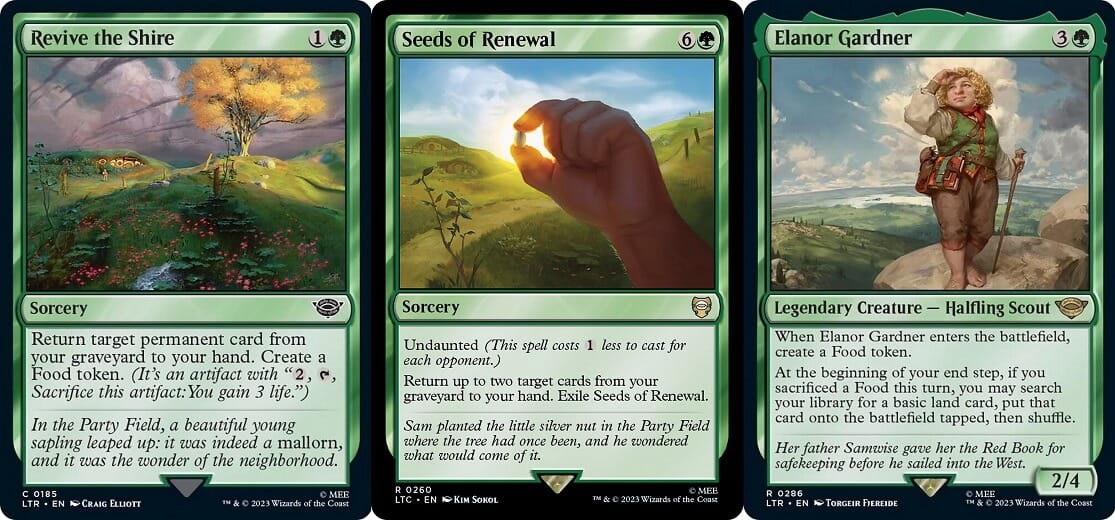
Other Individuals of Middle-earth in Magic: The Gathering
There are also some individuals who didn’t make the movies but are also in the set. They don’t tie together as well to a part of the book that was changed, and I’ll be looking at a few of them here.
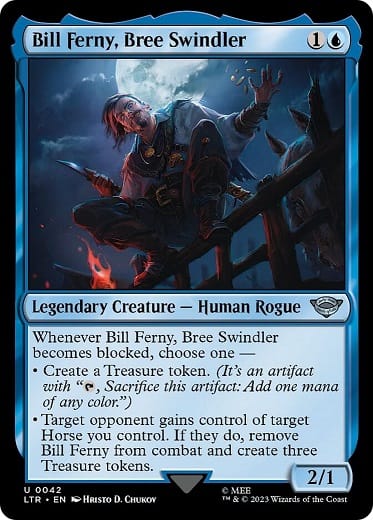
Left out of the movies, Bill Ferny helps push the danger in Bree by selling information about the hobbits to the Nazgul, as seen by Merry. Its likely that he also cut loose their mounts to further delay them, but because Bill Ferny only cares about Bill Ferny, he undercut his master for profit by selling to Aragorn Bill, the Pony at three times the going rate.
His card is somewhat inexplicably blue as Bill Ferny is a clearly black (as in the MTG color) character, and his abilities are also pretty well-aligned with black MTG cards. Still, once you get past he’s in the wrong color, the card is a neat bit of flavor, with him selling horses when he runs into people for three times their value and heading home, or just picking their pocket for a bit of money.
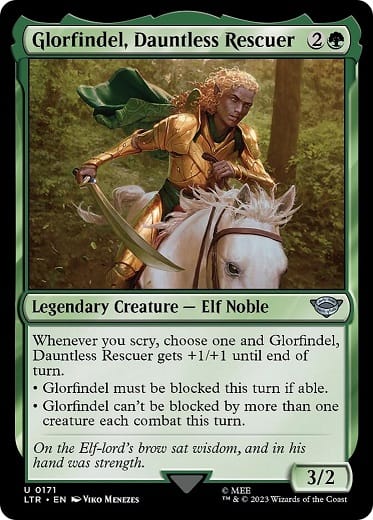
In the movie, Glorfindel’s role is taken by Arwen – it is he who raises the horses in the river Bruinen to flood the Nazgul and does a darring ride with Frodo to Rivendell to get him healing. He was part of the Council of Elrond, seated in a place of honor, and even considered as a possible member of the fellowship before it was decided that his power was unlikely to be of use in a mission needing utmost secrecy to reach Mordor.
Glorfindel’s card is a bit disappointing, as an uncommon he is clearly aimed at working with the UG Scrying Elf archtype. Still it seems to reference the ability to command attention or dismiss his foes to some extent by manipulating blockers.
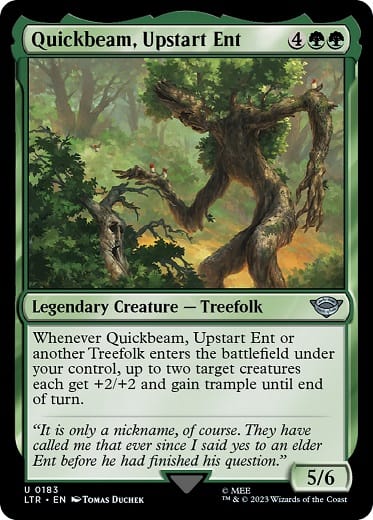
There was more than one notable Ent in the books with Quickbeam taking a role in Pippin and Merry’s story. Quickbeam, known somewhat more formally as Bregalad, is hastier than other Ents, and in fact is the first to vote to attack Sauruman. This leads to him getting assigned hobbit watcher, and he quickly becomes friends with them as well. He was one of the key Ent combatants as well, and along with Treebeard he nearly captured Sauruman.
His card lacks haste sadly, but it does capture the idea of him assaulting or supporting an assault by boosting other creatures on the battlefield when he, or another one of those less hasty treefolk arrive.
Lord of the Rings: Tales of Middle-earth does a good job of capturing many elements that make up the books, both well known and lesser known. I haven’t covered all the characters or instances that don’t make the leap, but I hope that I helped you learn just a bit more about Middle-Earth and that you enjoy the set.
Have a tip, or want to point out something we missed? Leave a Comment or e-mail us at tips@techraptor.net
